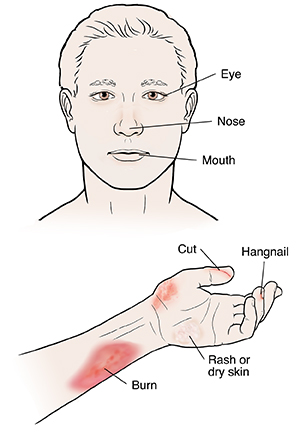In this article titled “Understanding Common Bloodborne Pathogens,” we aim to provide accurate and factual information about the most common bloodborne pathogens. As part of our commitment to promoting health and safety, we strive to equip readers with the knowledge they need to protect themselves and others from potential risks. By exploring the prevalence and characteristics of these pathogens, we hope to foster a deeper understanding of the importance of practicing proper prevention and precautions.
Understanding Common Bloodborne Pathogens

Introduction to Bloodborne Pathogens
Bloodborne pathogens are microorganisms such as viruses or bacteria that are present in human blood and can cause diseases. They can be transmitted to individuals through contact with infected blood or other bodily fluids. Understanding these pathogens is crucial in order to prevent their transmission and protect ourselves and others from potential infections.
Importance of Understanding Common Bloodborne Pathogens
In the healthcare field, and in various other professions, individuals are at risk of exposure to bloodborne pathogens. It is vital to have a comprehensive understanding of these pathogens to minimize the risk of infection and ensure the safety of both healthcare providers and patients. By understanding how these pathogens are transmitted and the diseases they can cause, appropriate preventive measures can be implemented to protect everyone involved.

Transmission of Bloodborne Pathogens
Bloodborne pathogens can be transmitted through various routes, including direct contact with infected blood or bodily fluids, such as saliva, semen, vaginal secretions, or breast milk. Other modes of transmission include contact with contaminated needles or other sharp objects, as well as through sexual contact and from mother to child during childbirth or breastfeeding. It is essential to practice proper infection control measures and precautions to prevent the spread of these pathogens.
Prevalence and Impact of Bloodborne Pathogens
Bloodborne pathogens pose a significant public health concern due to their prevalence and potential impact on individuals who become infected. According to the Centers for Disease Control and Prevention (CDC), millions of people are infected with bloodborne pathogens worldwide each year. These infections can lead to severe and potentially life-threatening diseases, contributing to a substantial burden on healthcare systems and economies.

Common Bloodborne Pathogens
Several bloodborne pathogens are of particular concern due to their prevalence and the diseases they can cause. The most common bloodborne pathogens include the Hepatitis B virus (HBV), Hepatitis C virus (HCV), Human Immunodeficiency Virus (HIV), Syphilis, and Malaria. Each of these pathogens has distinct characteristics and presents its own set of challenges when it comes to prevention and control.
Hepatitis B Virus (HBV)
HBV is a virus that infects the liver and can cause both acute and chronic hepatitis. It is primarily transmitted through contact with infected blood, but it can also be transmitted through sexual contact or from mother to child during childbirth. HBV can lead to serious health complications, such as liver cirrhosis and liver cancer. However, vaccination is available to prevent HBV infection, and proper infection control measures can help reduce the risk of transmission.

Hepatitis C Virus (HCV)
Similar to HBV, HCV also infects the liver and can cause chronic hepatitis. It is most commonly spread through exposure to infected blood, such as through needle sharing among individuals who inject drugs. HCV can lead to liver damage, including cirrhosis and liver cancer. There is no vaccine for HCV, but early diagnosis and appropriate treatment can help prevent long-term complications and reduce the risk of transmission.
Human Immunodeficiency Virus (HIV)
HIV attacks the immune system and weakens its ability to fight off infections and diseases. It is mainly transmitted through sexual contact, sharing needles, and from mother to child during childbirth or breastfeeding. HIV can progress to acquired immunodeficiency syndrome (AIDS), a condition characterized by severe immune system damage. Although there is no cure for HIV, antiretroviral therapy can manage the virus and significantly decrease the risk of transmission.
Syphilis
Syphilis is a bacterial infection that can be transmitted through sexual contact or from mother to child during pregnancy. It progresses in stages and can affect various organs and systems throughout the body. If left untreated, syphilis can lead to serious complications, including damage to the brain, heart, and other organs. However, early diagnosis and appropriate treatment with antibiotics can effectively cure syphilis and prevent further complications.
Malaria
Malaria is caused by a parasite that is transmitted through the bite of infected female Anopheles mosquitoes. It primarily affects individuals residing in or traveling to tropical and subtropical regions. Malaria can cause severe fever, chills, and flu-like symptoms, and in severe cases, it can be life-threatening. Prevention measures such as the use of insect repellents, bed nets, and antimalarial medications can help reduce the risk of contracting malaria.
Prevention and Control of Bloodborne Pathogens
Preventing the transmission of bloodborne pathogens is crucial for the safety and wellbeing of individuals. Implementing appropriate infection control measures, such as proper hand hygiene, the use of personal protective equipment (PPE), safe needle handling, and proper disposal of contaminated materials, can help reduce the risk of exposure. Additionally, education and training programs on bloodborne pathogens should be provided to healthcare professionals and individuals at risk to promote awareness and ensure proper preventive measures are followed.
In conclusion, a thorough understanding of common bloodborne pathogens is essential for healthcare providers, workers in high-risk professions, and the general population. By recognizing transmission routes, prevalence, and impact, individuals can take appropriate measures to prevent the spread of these pathogens. Through vaccination, proper infection control practices, and targeted interventions, the risk of bloodborne infections can be significantly reduced, protecting both individuals and communities.









